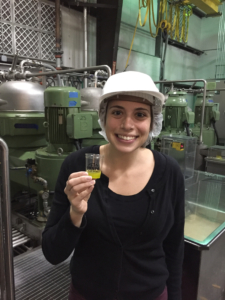Caffeine Awareness Month: Myth-busting and fact-checking – National Consumers League
![]() Whether you’re working an 8-hour day, at home with the kids, or even trying to burn some excess calories at the gym after work, caffeine is usually within close reach, in one form or another. Within close reach there’s also a multitude of information. But how much of this is true? And, where are the information gaps for consumers?
Whether you’re working an 8-hour day, at home with the kids, or even trying to burn some excess calories at the gym after work, caffeine is usually within close reach, in one form or another. Within close reach there’s also a multitude of information. But how much of this is true? And, where are the information gaps for consumers?
For the third consecutive year during March, we take a closer look at caffeine – this time fact checking those myths and arming you with some truths that will help you make informed choices. And urging better consumer information, namely that the label of caffeinated products should include amount of caffeine in the products.
1. Americans are drinking more caffeine than ever before
FALSE! Despite concerns expressed about proliferation of caffeine in the food supply, *statistics indicate that there has not been an overall increase in caffeine intake in the United States in recent years. The principal dietary sources of caffeine also remain the same, with most intake of caffeine remaining from coffee, tea, and soda. This is consistent with a recent FDA-sponsored *study that found between 70 and 90 percent of caffeine intake is from coffee and tea.
2. Slamming down a caffeinated drink quickly will have more of an effect than sipping it slowly
FALSE! Whether you are on the go and consume a drink quickly, or like to sit and enjoy a drink with friends, there is no difference in caffeine’s effect on you. However, the speed of your own metabolism may influence digestion time.
3. Added caffeine is stronger than naturally occurring sources of caffeine
FALSE! Caffeine is caffeine! There is no chemical or biological difference between the naturally-occurring caffeine in plants – like in coffee, tea, and chocolate – and synthetic caffeine commonly used in sodas, energy drinks, and supplements.
4. Dogs and cats should not consume caffeine
TRUE! While 85 percent of human Americans drink coffee everyday, 100 percent of our furry friends must be kept away from sources of caffeine. Dogs, cats, and birds are more sensitive to the effects of caffeine than people are, and even the smallest amount (depending on breed, weight and other factors) can have severe consequences.
5. Dark roasted coffee is stronger than lighter roasts
FALSE! Contrary to what many people assume, the darker the coffee roast, the LESS caffeine it has. This is because caffeine is heat sensitive, so if you roast coffee beans longer, they will contain less caffeine. For tea, it’s the opposite: the darker the tea, the higher the caffeine content.
6. Guarana is just another form of caffeine
TRUE! Caffeine is found naturally in over 60 plants including coffee beans, cocoa beans, tea leaves, kola nuts, yerba mate, and guarana.
7. Three cups per day is the maximum amount of coffee an adult should consume
IT DEPENDS… on the type of coffee, the size of your cup, and even how it was prepared. One thing’s for sure: the FDA, Health Canada, and the European Food Safety Authority all acknowledge that 400mg of caffeine per day is a moderate safe daily intake amount for healthy adults. How much is 400mg in terms of cups or servings? See below from lowest to highest caffeine concentration:
- 16.6 servings of green tea (8 oz./24 mg caffeine)
- 11.5 servings of brand cola (8 oz./average 35 mg caffeine)
- 8.5 servings of black tea (8 oz./47 mg caffeine)
- 5 servings of Red Bull energy drink (8 oz./80 mg caffeine)
- 4.2 servings of regular brewed coffee (8 oz./95.2 mg caffeine)
- 2 servings of 5-Hour Energy (2 oz./200 mg caffeine)
- <1 serving of energy shots (8 oz./average 480 mg caffeine)
8. Energy Drinks contain large amounts of caffeine
FALSE! The major energy drink brands (Red Bull and Monster) contain between 80 to 120 mg caffeine per serving. For comparison purposes, a cup of home brewed coffee contains approximately 80 mg per cup while a store bought cold brew coffee can have up to 250 mg. An 8-oz. energy shot contains 480 mg caffeine.
9. Some people should limit their caffeine consumption
TRUE! Caffeine sensitive people, pregnant women, those who are capable of becoming pregnant, and those who are breastfeeding should consult their health care providers for advice concerning caffeine consumption. Children and teens should generally consume less caffeine due to lower body weight than adults (and parents should monitor).
10. All caffeine products declare the amount of caffeine they contain
FALSE! NCL believes that ALL products containing caffeine – no matter whether naturally occurring, contained in a cup, a can, or a candy bar wrapper – should declare the amount of caffeine on the label.
While the FDA *requires food labels to disclose added caffeine as an ingredient, the label is not required to provide the amount of caffeine. Very few products list the amount of caffeine they contain, although some companies, like Red Bull and Monster, provide this information voluntarily.
But, would it be so hard for all producers to provide caffeine content on the information panel?
National Nutrition Month is an annual initiative led by the Academy of Nutrition and Dietetics. DISCLOSURE: While researching facts for this blog, approximately 220 mg of caffeine (3 cups of cappuccino) was consumed!
*Links are no longer active as the original sources have removed the content, sometimes due to federal website changes or restructurings.

























